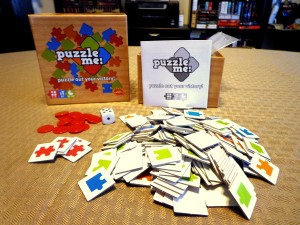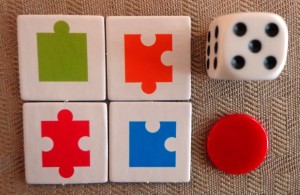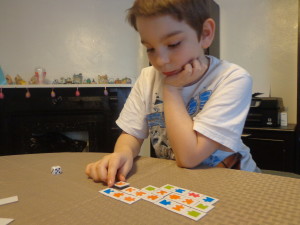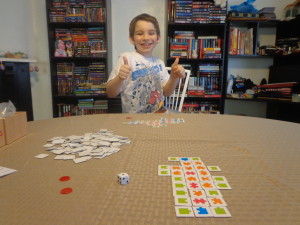I give a lot of credit to those who have the patience to sit down with a large jigsaw puzzle and attempt to piece it together, is hard thinking piece a puzzle, choosing This or That is not easy . In my house, a jigsaw puzzle would have a shelf life of about two hours before something “accidentally” happened to it. “Puzzle Me!”, while having a jigsaw puzzle theme, isn’t about spending hours/days to assemble a picture. Rather, players will be trying to build their own crossword as large as they can while trying to stop their opponents from doing the same. Before we take a look at this game in further detail, I’d like to thank Richard Reyes from Brainstormers for sending me a free review copy.
Components
Puzzle Pieces – These square, cardboard pieces display puzzle pieces of varying shapes and colors.
Karma Tokens – These tokens act as counters, which are exchanged between players during the course of the game.
Die – There is one, six-sided die.
Setup & Gameplay
Each player receives one red, four connector puzzle piece and two karma tokens. The rest of the pieces are flipped face down and mixed up to form the draw pile. Finally, players roll the die to assign the starting player.
The object of “Puzzle Me!” is to be the player that forms the largest puzzle while accumulating the least amount of karma tokens. On a player’s turn, they’ll perform the following actions:
1) Roll the six-sided die, indicating how many face down puzzle pieces are drawn and revealed from the draw pile. These tiles will be used for placement by that player.
2) A player can place a puzzle piece on their own grid, or place a puzzle piece on their opponent’s grid. A player that does the latter must take one of their opponent’s karma tokens. A player that doesn’t have karma tokens is immune to other players being able to play pieces on their grid.
When the player has played all possible pieces for that turn, the rest of the unused pieces go back into the draw pile. Play proceeds clockwise and the process repeats. When a player’s puzzle is closed (no more pieces can be added to it), the final round begins. Each player (except for the player who closed the puzzle) takes one last turn. After that, players give themselves one point for every piece they have in their grid and subtract one point for each karma token they have. Whoever has the most points wins the game!
The above is simply an overview of the game, but should give you an idea of how it is played. For more information, please check out the links I provided at the end of this article.
The Review
The game itself is packaged in a small box, making it convenient to bring with you on trips. You won’t be able to play the game in a car or on unsteady surfaces, but it is light enough to bring with you on vacation or over someone else’s house without hassle. The pieces are small which may strain the eyesight of some, though the color coding of the pieces (which I’ll get to in a moment) make it easier to see what’s what at a glance. The game includes two baggies, which are more than large enough to hold the pieces. There’s also plenty of room for the box to close, so you won’t have to worry about jamming pieces together.
I appreciate the fact that there is a pattern to the colors and shapes. Red puzzle pieces have four connectors, orange puzzle pieces have three connectors, blue puzzle pieces have two connectors, and green puzzle pieces have one. I found that this mechanic allowed me to easily see what sections of my opponent’s grid might be exploitable. As I indicated above, the puzzle pieces might appear small to some, but at least you’ll know how many connectors you can expect on a piece just by identifying the color.
The karma mechanic is interesting, as it allows players to be sneaky and mess up someone else all the while making themselves more vulnerable. In theory, you could allow someone to mess you up twice and so as long as you don’t go on the offensive, you’ll be immune to such attacks for the rest of the game. On the other hand, going on the offensive might do you good if you see that your opponent is building themselves a large grid with no signs of slowing down. Adding to an opponent’s grid might mess them up a bit, but it also contributes to their score. Going on the offensive is a risky strategy in this game, though some might find it to be a necessary evil, depending on the situation.
Vinnie (12) had an easy time with the game, but it still made him think. I could tell that he was trying to position his pieces in a way that would allow him to expand his grid more. I’m grateful that this game is helping to teach him organization, something he could certainly improve upon. The act of planning ahead and thinking of the bigger picture also serves to improve his critical thinking skills. Two advanced rule variants are available in the manual, which certainly help to keep things engaging when we play over extended periods of time. In addition to the two official variants, the game is flexible enough to where players can create their own. For example, I created my own house rules that allows players to put back pieces that they draw. This opens the door for more strategic play, as players can either hold back on playing weaker pieces in an effort to grow their puzzle, or play as many as they can in the hopes of closing off their puzzle while in the lead.
Overall, “Puzzle Me!” is an excellent pick-up-and-play brainteaser that is fun to play. It has educational value and can be played in a half hour or less, making it an ideal game to quickly play on a school night. I have a few parent friends that often complain that they can’t play games like “Stone Age” or “Pandemic” with their kids due to the age barrier. In this case, these parents will be pleased to know that kids of most ages will have no trouble with this game. The recommended age is six and up, but it’s up to the individual parent to make that call considering that the pieces are small and thus could be a choking hazard. With that said, “Puzzle Me!” could possibly be a good “co-op” activity for parents and their much younger children.
The game is currently available for pre-order on the GameSalute website for $12.00, with a “street date” of 3/22/13. Seeing that we’re halfway into April, it’s possible that the game has been delayed. The game’s Kickstarter page shows an update by the developer that mentions a ship date of late April / early May, so it should be arriving to Kickstarter supporters soon, if not already.
Final Verdict: 8/10
—
You can learn more about and purchase “Puzzle Me!” by visiting the following websites:
http://shop.gamesalute.com/products/puzzle-me
http://boardgamegeek.com/boardgame/114050/puzzle-me
http://www.kickstarter.com/projects/brainstormers/puzzle-me-a-family-friendly-board-game/posts
—




